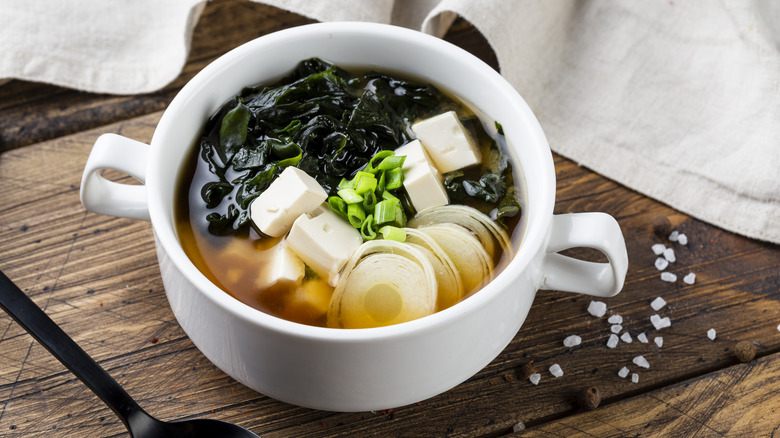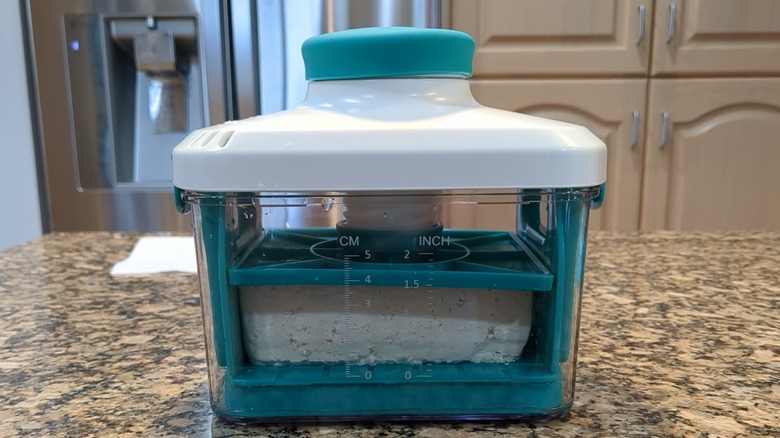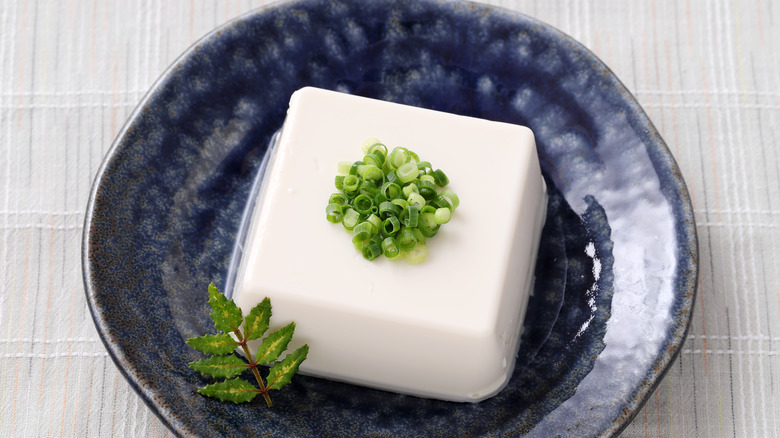You Need To Press Tofu, Even If You Add It To Soup
A timeless, low-maintenance, one-pot dish that comes in many shapes, sizes, and shades of flavor, soup is a culinary classic that brings warmth and comfort with every spoonful. Although a heaping pot of brothy meatballs or a cold-curing chicken noodle soup recipe are two deliciously meaty options, tofu is the perfect protein alternative for vegans, vegetarians, and foodies looking to shake up their soup routine. But before you make a tofu soup, however, you should always press your tofu, even if it seems futile.
We know what you're thinking — why press tofu just to simmer it in liquid? Isn't pressing reserved recipes that require firm, moisture-free tofu? If you skip out on pressing tofu before adding it to soup, it runs the risk of falling apart, losing shape, and mutating into a sloppy, slippery, and soggy mess. Plus, when you press excess moisture out of a block of tofu, the channels that once held the water transform into empty reserves primed to absorb the bold flavors of your favorite soup recipe. Lastly, the broth-to-ingredient ratio in a soup is important for striking the perfect textural balance, and un-pressed tofu releases added liquid to the simmering pot, potentially disrupting that essential equilibrium.
How to press tofu for soup
Pressing tofu doesn't require much skill or finesse. However, there are some ways to maximize efficiency for the perfect tofu texture and flavor.
You'll be surprised at just how much water is removed from tofu while it's being pressed. After opening and draining the package, wrap your tofu in a thick layer of paper towels or a clean tea towel to absorb the liquid and avoid a slippery mess on your kitchen counter. Once wrapped, place a heavy item directly on top of the tofu block. A cast iron pan topped with canned foods, a thick cookbook, a closed coffee pot filled with water, or a large cutting board are all great options.
If you don't want to MacGyver a weight, consider purchasing a tofu press — a handy gadget that evenly presses out excess moisture with minimal effort. Thirty minutes of pressing is all you need to remove excess moisture from tofu, but you can also leave it overnight. However, if you are pressing it for more than two hours, let it sit in the fridge to avoid consuming bacteria-laden tofu soup. Finally, introduce tofu to your soup during the last 10 to 15 minutes of cooking to maintain its firmness.
The exemption for pressing tofu for soup
Pressing tofu for soup is recommended in most instances. However, there is one exemption that allows you to forgo this process.
You shouldn't press tofu for soup if you're working with silken tofu. Its smooth, gelatin-like texture easily folds under the pressure of added weight, pulverizing it before you can enjoy it. Even if it doesn't get crushed, silken tofu adds a rich creaminess to soups that's compromised when pressed. Because it has more water content than any other variety, silken tofu should be added towards the very end of the cooking process to prevent it from falling apart in the boiling liquid. Although it can be just as delicious as firm tofu, bear in mind that you'll be doing more slurping than chewing when making silken tofu soup.
Working with silken tofu is the only time you should skip the pressing process. Whether you're making a comforting fall soup or one that's bright and summery, avoid making common tofu mistakes by thoroughly pressing it before adding it to your favorite spoonable dish.


